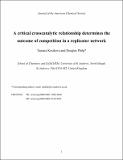Files in this item
A critical cross-catalytic relationship determines the outcome of competition in a replicator network
Item metadata
| dc.contributor.author | Kosikova, Tamara | |
| dc.contributor.author | Philp, Douglas | |
| dc.date.accessioned | 2018-08-03T23:34:32Z | |
| dc.date.available | 2018-08-03T23:34:32Z | |
| dc.date.issued | 2017-09-13 | |
| dc.identifier | 250656295 | |
| dc.identifier | a2cbcc2b-583a-442d-8dcb-6d4369ddaf3d | |
| dc.identifier | 85029507425 | |
| dc.identifier | 000411043900044 | |
| dc.identifier.citation | Kosikova , T & Philp , D 2017 , ' A critical cross-catalytic relationship determines the outcome of competition in a replicator network ' , Journal of the American Chemical Society , vol. 139 , no. 36 , pp. 12579-12590 . https://doi.org/10.1021/jacs.7b06270 | en |
| dc.identifier.issn | 0002-7863 | |
| dc.identifier.other | ORCID: /0000-0002-9198-4302/work/56639244 | |
| dc.identifier.uri | https://hdl.handle.net/10023/15767 | |
| dc.description | The financial support for this work was provided by the University of St Andrews and the Engineering and Physical Sciences Research Council (Grant EP/K503162/1). | en |
| dc.description.abstract | A network of two synthetic replicators exhibits a critical unidirectional cross-catalytic relationship that directs competing replication processes. In this network, nitrone N bearing a 6-methylamidopyridine recognition site can participate in 1,3-dipolar cycloaddition reactions with two maleimides that differ in the relative position of their carboxylic acid recognition site: either para (Mp) or meta (Mm) relative to the maleimide ring. These cycloaddition reactions create replicators trans-Tp and trans-Tm. In isolation, trans-Tp templates its own formation with an efficiency that is markedly greater than that of trans-Tm. Kinetic fitting and simulations reveal that this efficiency arises from a higher template-mediated rate constant for the cycloaddition and lower stability of the trans-Tp template duplex, compared to trans-Tm. By contrast, in a situation where Mp and Mm compete for a limited quantity of N, the normally less efficient trans-Tm outcompetes trans-Tp. Through a series of comprehensive kinetic 19F{1H} NMR spectroscopy experiments, this system-level outcome is traced to a critical cross-catalytic pathway, whereby the presence of trans-Tp templates the formation of trans-Tm, but not vice versa. Replicator trans-Tm also reduces the efficiency of its competitor trans-Tp by sequestering trans-Tp in a heteroduplex that is more stable than homoduplex [Tp•Tp]. The addition of different templates as instructions reveals that, while the outcome of competition between replicators can be altered selectively, it is limited by the reaction environment employed. These results represent a conceptual and practical framework for the examination of selectivity in replication networks operating outside well-stirred batch reactor conditions. | |
| dc.format.extent | 12 | |
| dc.format.extent | 6517078 | |
| dc.language.iso | eng | |
| dc.relation.ispartof | Journal of the American Chemical Society | en |
| dc.subject | QD Chemistry | en |
| dc.subject | DAS | en |
| dc.subject | BDC | en |
| dc.subject | R2C | en |
| dc.subject.lcc | QD | en |
| dc.title | A critical cross-catalytic relationship determines the outcome of competition in a replicator network | en |
| dc.type | Journal article | en |
| dc.contributor.institution | University of St Andrews. School of Chemistry | en |
| dc.contributor.institution | University of St Andrews. EaSTCHEM | en |
| dc.contributor.institution | University of St Andrews. Biomedical Sciences Research Complex | en |
| dc.identifier.doi | 10.1021/jacs.7b06270 | |
| dc.description.status | Peer reviewed | en |
| dc.date.embargoedUntil | 2018-08-04 |
This item appears in the following Collection(s)
Items in the St Andrews Research Repository are protected by copyright, with all rights reserved, unless otherwise indicated.

